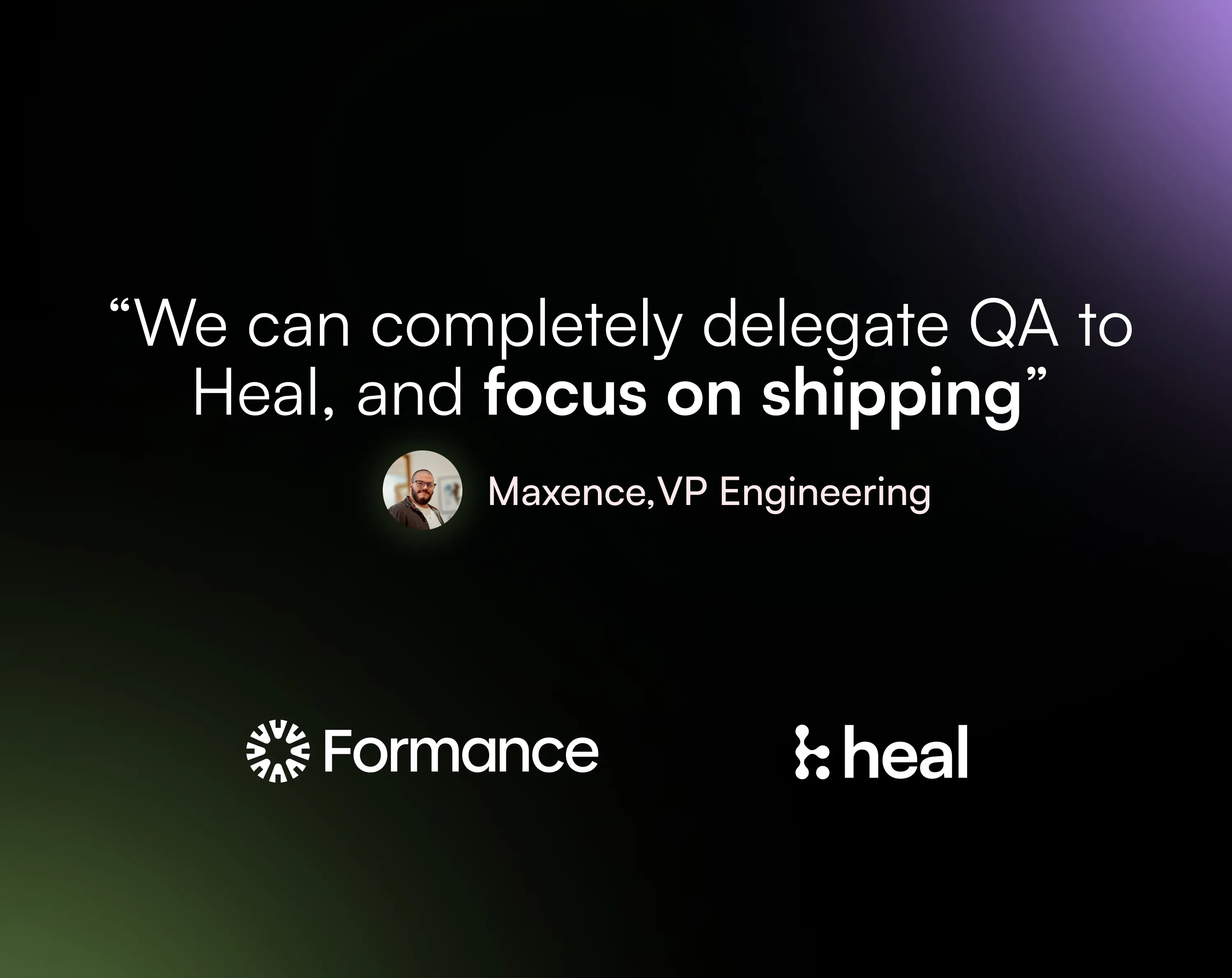Formance
Heal helps Formance ship faster and reduce the number of production bugs by 90%.

About Formance
Formance is an open-source financial infrastructure provider, redefining how developers interact with money as a first-class primitive by empowering them to embed complex money flows directly into their applications.
About Heal
Heal.dev is an AI-powered QA engineer that writes, maintains & analyses hundreds of end-to-end tests, without having to scale a QA team. It helps high-leverage engineering teams save up to 7 hours per week per engineer and cut production bugs by 90%.
Heal was way faster to deploy than a QA engineer coming in and rolling out tests. Recruiting and managing a QA engineer takes time. With Heal, the problem was solved in 2 weeks.

Max Maireaux
VP Engineering, Formance
Critical software meets an AI QA engineer
Formance is building an open-source financial core that leading companies use to power their financial backend. Ultimately, it powers the transactions of hundreds of millions of end users around the world. Formance has a small, efficient engineering team that strives to ship complex software fast. But speed and complexity don’t always mix well when you’re shipping critical infrastructure. It takes a lot of effort to move fast withoutbreaking things.
"Before Heal, shipping a new feature often meant something broke in the UI. We have a very low tolerance for bugs, so we needed to fix that”, recalls Maxence Maireaux, VP Engineering at Formance. “We considered writing end-to-end test cases ourselves. But the frontend team is small, so we always needed them to focus on something else. Tests were always deprioritized."
Often, the options at this stage are to either invest precious engineering time in setting up and maintaining test automation or to hire an external consultant to do it. Both eventually result in increased headcount, management overhead, and loss of focus. So what should modern, nimble engineering teams do?
“The idea with Heal was ‘we can delegate QA fully to Heal, and focus on shipping‘. We had end-to-end tests in the past, but it was painful to maintain them, even with the right tooling”, says Maxence.
Best of both worlds: an embedded QA engineer
Heal acts like a full QA engineer embedded in your team. It writes test cases from natural language scenarios, maintains them over time, and automatically finds the root cause of failures. When a bug is found, Heal files detailed, developer-ready reports, so your team can fix it fast and skip the guesswork.
Heal is unique in that it combines an AI agent to write, maintain, and analyze tests, and a team of human QA engineers in the loop to make the results perfect. Heal’s QA experts optimize test plans, ensure the test code is clean and maintainable, and handle edge cases when needed. When a test fails, Heal's automated Triage agent investigates the root cause and brings in a human reviewer from the Heal team if necessary. Only confirmed, reproducible bugs are reported to the team. No noise, no false positives. This allows high-leverage engineering teams to rely on Heal as a scalable QA engineering team mate.
Unlike most AI-powered tooling, it’s a standalone, drop-in replacement for a QA team. Unlike a consultant, it delivers results fast and grows with Formance’s needs without management overhead.
“Heal was way faster to deploy than a QA engineer coming in and rolling out tests. Recruiting and managing a QA engineer takes time. With Heal, the problem was solved in 2 weeks.”
90% of bugs caught before production
At Formance, Heal runs a full test suite regularly. Bug reports are posted in Slack by the Heal Slack bot, and the Formance team can collaborate with Heal there. So far, this has allowed Formance to exponentially decrease the number of bugs shipped to production, while keeping velocity high.
“If customers stop surfacing bugs, or the number keeps going down, we’re winning. That’s exactly what we’ve achieved with Heal. Since we’ve deployed Heal, the amount of front-end problems has decreased exponentially.”, summarizes Maxence. “Last month, Heal caught 90% of bugs before shipping to production1. And as we expand coverage, we’re catching even more.”
(1) Methodology: Count linear tickets tracking bugs not caught by Heal (NC). Count Linear tickets opened following a Heal bug report (C). The ratio is C / (NC+C) .